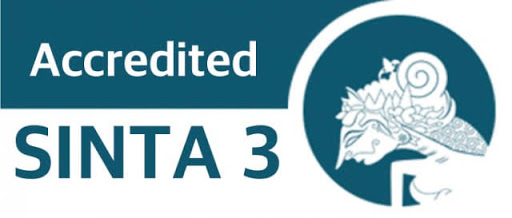Developing Moodle-based e-learning on the topic of logarithm for the tenth-grade students of SMA N 1 Sewon
DOI:
https://doi.org/10.12928/ijei.v1i2.2618Keywords:
ADDIE, e-learning, logarithm, MoodleAbstract
The development of technology and communication has an impact on all aspects of life, including in the learning process using media. This study aims to develop e-learning platform by using Moodle on logarithmic material for ten grader students of SMA Negeri 1 Sewon. This development research uses the ADDIE model. The subjects of this study were learning material expert, learning media expert, and 10 grader students of SMA Negeri 1 Sewon. Data collection techniques were carried out by interviews, questionnaires, and observations. The data analysis techniques were conducted by converting qualitative data into quantitative data using a Likert scale. The results obtained from experts in the material included in the feasible category, the results obtained by media experts included in the feasible category, and the results of student assessment obtained as a feasible category. Based on these results, it can be concluded that the learning media developed can be used in the process of learning mathematics.References
Aditya, P. T. (2018). Pengembangan media pembelajaran matematika berbasis web pada materi lingkaran bagi siswa kelas VIII. Jurnal Matematika, Statistika dan Komputasi, 15(1), 64-74.
Cartono, C., Fazriyah, N., & Hendrayana, S. (2019, April). Implementation of Moodle as teaching tool in learning concept science. In 3rd Asian Education Symposium (AES 2018) (pp. 96-98). Atlantis Press.
Fahmi, S. (2018). Membangun Multimedia Interaktif. Yogyakarta: Bildung.
Istiandaru, A. (2014). PBL Pendekatan Realistik Saintifik dan Asesmen PISA untuk Meningkatkan Kemampuan Literasi Matematika. Unnes Journal of Mathematics Education Research, 3(2).
Muin, A., & Ulfah, R. M. (2012). Meningkatkan hasil belajar matematika siswa dengan pembelajaran menggunakan aplikasi Moodle. Pythagoras: Jurnal Pendidikan Matematika, 7(1).
Pastore, R. (2002). Elearning in education: An overview. In Society for Information Technology & Teacher Education International Conference (pp. 275-276). Association for the Advancement of Computing in Education (AACE).
Samsuddin, Y., Rahman, A., & Nadjib, M. (2016). Pemanfaatan e-learning moodle pada mata pelajaran matematika di SMK Negeri 5 Makassar. KAREBA: Jurnal Ilmu Komunikasi, 2(1), 65-72.
Sukmadinata, N. S. (2007). Metode Penelitian Pendidikan. Bandung: Remaja Rosdakarya.
Widoyoko, E. P. (2017). Evaluasi Program Pelatihan. Yogyakarta: Pustaka Pelajar.
Cartono, C., Fazriyah, N., & Hendrayana, S. (2019, April). Implementation of Moodle as teaching tool in learning concept science. In 3rd Asian Education Symposium (AES 2018) (pp. 96-98). Atlantis Press.
Fahmi, S. (2018). Membangun Multimedia Interaktif. Yogyakarta: Bildung.
Istiandaru, A. (2014). PBL Pendekatan Realistik Saintifik dan Asesmen PISA untuk Meningkatkan Kemampuan Literasi Matematika. Unnes Journal of Mathematics Education Research, 3(2).
Muin, A., & Ulfah, R. M. (2012). Meningkatkan hasil belajar matematika siswa dengan pembelajaran menggunakan aplikasi Moodle. Pythagoras: Jurnal Pendidikan Matematika, 7(1).
Pastore, R. (2002). Elearning in education: An overview. In Society for Information Technology & Teacher Education International Conference (pp. 275-276). Association for the Advancement of Computing in Education (AACE).
Samsuddin, Y., Rahman, A., & Nadjib, M. (2016). Pemanfaatan e-learning moodle pada mata pelajaran matematika di SMK Negeri 5 Makassar. KAREBA: Jurnal Ilmu Komunikasi, 2(1), 65-72.
Sukmadinata, N. S. (2007). Metode Penelitian Pendidikan. Bandung: Remaja Rosdakarya.
Widoyoko, E. P. (2017). Evaluasi Program Pelatihan. Yogyakarta: Pustaka Pelajar.
Downloads
Published
2021-03-26
Issue
Section
Articles
License
Authors who publish with this journal agree to the following terms:
- Authors retain copyright with the work simultaneously licensed under a Creative Commons Attribution License that allows others to share the work with an acknowledgement of the work's authorship and initial publication in this journal.
- Authors are able to enter into separate, additional contractual arrangements for the non-exclusive distribution of the journal's published version of the work (e.g., post it to an institutional repository or publish it in a book), with an acknowledgement of its initial publication in this journal.
- Authors are permitted and encouraged to post their work online (e.g., in institutional repositories or on their website) prior to and during the submission process, as it can lead to productive exchanges, as well as earlier and greater citation of published work (See The Effect of Open Access).




